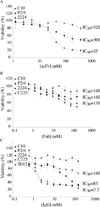Impact of intrinsic affinity on functional binding and biological activity of EGFR antibodies
- PMID: 22564724
- PMCID: PMC4209485
- DOI: 10.1158/1535-7163.MCT-11-1038
Impact of intrinsic affinity on functional binding and biological activity of EGFR antibodies
Abstract
Aberrant expression and activation of EGF receptor (EGFR) has been implicated in the development and progression of many human cancers. As such, targeted therapeutic inhibition of EGFR, for example by antibodies, is a promising anticancer strategy. The overall efficacy of antibody therapies results from the complex interplay between affinity, valence, tumor penetration and retention, and signaling inhibition. To gain better insight into this relationship, we studied a panel of EGFR single-chain Fv (scFv) antibodies that recognize an identical epitope on EGFR but bind with intrinsic monovalent affinities varying by 280-fold. The scFv were converted to Fab and IgG formats, and investigated for their ability to bind EGFR, compete with EGF binding, and inhibit EGF-mediated downstream signaling and proliferation. We observed that the apparent EGFR-binding affinity for bivalent IgG plateaus at intermediate values of intrinsic affinity of the cognate Fab, leading to a biphasic curve describing the ratio of IgG to Fab affinity. Mathematical modeling of antibody-receptor binding indicated that the biphasic effect results from nonequilibrium assay limitations. This was confirmed by further observation that the potency of EGF competition for antibody binding to EGFR improved with both intrinsic affinity and antibody valence. Similarly, both higher intrinsic affinity and bivalent binding improved the potency of antibodies in blocking cellular signaling and proliferation. Overall, our work indicates that higher intrinsic affinity combined with bivalent binding can achieve avidity that leads to greater in vitro potency of antibodies, which may translate into greater therapeutic efficacy.
©2012 AACR.
Conflict of interest statement
Disclosure of potential conflicts of interests: J.D. Marks has major ownership interest in Merrimack Pharmaceuticals. He also is a consultant and on the scientific advisory board of Merrimack Pharmaceuticals. The other authors disclosed no potential conflicts of interest.
Figures




References
-
- Ozanne B, Richards CS, Hendler F, Burns D, Gusterson B. Over-expression of the EGF receptor is a hallmark of squamous cell carcinomas. J Pathol. 1986;149:9–14. - PubMed
-
- Di Fiore PP, Pierce JH, Fleming TP, Hazan R, Ullrich A, King CR, et al. Overexpression of the human EGF receptor confers an EGF-dependent transformed phenotype to NIH 3T3 cells. Cell. 1987;51:1063–1070. - PubMed
-
- Velu TJ, Beguinot L, Vass WC, Willingham MC, Merlino GT, Pastan I, et al. Epidermal-growth-factor-dependent transformation by a human EGF receptor proto-oncogene. Science. 1987;238:1408–1410. - PubMed
-
- Salomon DS, Brandt R, Ciardiello F, Normanno N. Epidermal growth factor-related peptides and their receptors in human malignancies. Crit Rev Oncol Hematol. 1995;19:183–232. - PubMed
-
- Motoyama AB, Hynes NE, Lane HA. The efficacy of ErbB receptor-targeted anticancer therapeutics is influenced by the availability of epidermal growth factor-related peptides. Cancer Res. 2002;62:3151–3158. - PubMed
Publication types
MeSH terms
Substances
Grants and funding
LinkOut - more resources
Full Text Sources
Other Literature Sources
Research Materials
Miscellaneous

